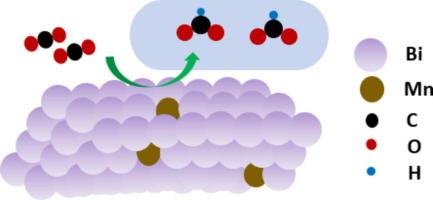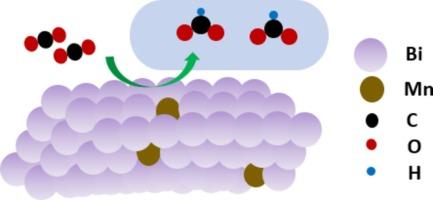在经 PTFE 处理的碳纸上生长的掺锰 Bi2O3,用于电化学生产二氧化碳-甲酸盐
IF 6.5
1区 化学
Q2 CHEMISTRY, PHYSICAL
引用次数: 0
摘要
在催化二氧化碳电化学还原为甲酸盐的过程中,生物氧化物显示出良好的选择性,但该过程存在过电位高、速率低的问题。此外,在电化学条件下,活性位点仍然模糊不清。在此,我们引入了掺锰技术来提高无粘结剂 Bi2O3 的活性,并通过原位拉曼和密度泛函理论(DFT)分析对活性位点进行了阐述。掺杂锰的 Bi2O3 在 KHCO3 中转化为掺杂锰的 Bi2(CO3)O2,随后在阴极电位下还原为锰修饰的金属 Bi。未掺杂的 Bi2O3 也发生了相同的相变,但速度不同。DFT 分析了在 Bi(012) 中掺杂锰的影响,结果表明甲酸盐生成的选择性显著提高。此外,研究还证明了基底疏水性对长期稳定性的重要性。这项研究为设计和理解基于掺杂 BiOx 的二氧化碳还原电极提供了深入的见解。本文章由计算机程序翻译,如有差异,请以英文原文为准。


Mn-doped Bi2O3 grown on PTFE-treated carbon paper for electrochemical CO2-to-formate production
BiOx shows promising selectivity in catalyzing the electrochemical reduction of CO2 to formate, but the process suffers from high overpotential and a low rate. Moreover, the active sites are still ambiguous under electrochemical conditions. Herein, we introduce Mn-doping to enhance the activity of binder-free Bi2O3 and elaborate on active sites through in situ Raman and density functional theory (DFT) analyses. The Mn-doped Bi2O3 transforms to Mn-doped Bi2(CO3)O2 in KHCO3 and subsequently reduces to Mn-modified metallic Bi under cathodic potentials. The undoped Bi2O3 is found to follow the same phase transitions but at a different rate. The DFT analyzes the impact of doping the Bi(012) with Mn and indicates significantly improved selectivity for formate generation. Further, the importance of the substrate’s hydrophobicity for long-term stability is demonstrated. This study offers in-depth insights into the design and understanding of doped BiOx-based electrodes for CO2 reduction.
求助全文
通过发布文献求助,成功后即可免费获取论文全文。
去求助
来源期刊

Journal of Catalysis
工程技术-工程:化工
CiteScore
12.30
自引率
5.50%
发文量
447
审稿时长
31 days
期刊介绍:
The Journal of Catalysis publishes scholarly articles on both heterogeneous and homogeneous catalysis, covering a wide range of chemical transformations. These include various types of catalysis, such as those mediated by photons, plasmons, and electrons. The focus of the studies is to understand the relationship between catalytic function and the underlying chemical properties of surfaces and metal complexes.
The articles in the journal offer innovative concepts and explore the synthesis and kinetics of inorganic solids and homogeneous complexes. Furthermore, they discuss spectroscopic techniques for characterizing catalysts, investigate the interaction of probes and reacting species with catalysts, and employ theoretical methods.
The research presented in the journal should have direct relevance to the field of catalytic processes, addressing either fundamental aspects or applications of catalysis.
 求助内容:
求助内容: 应助结果提醒方式:
应助结果提醒方式:


